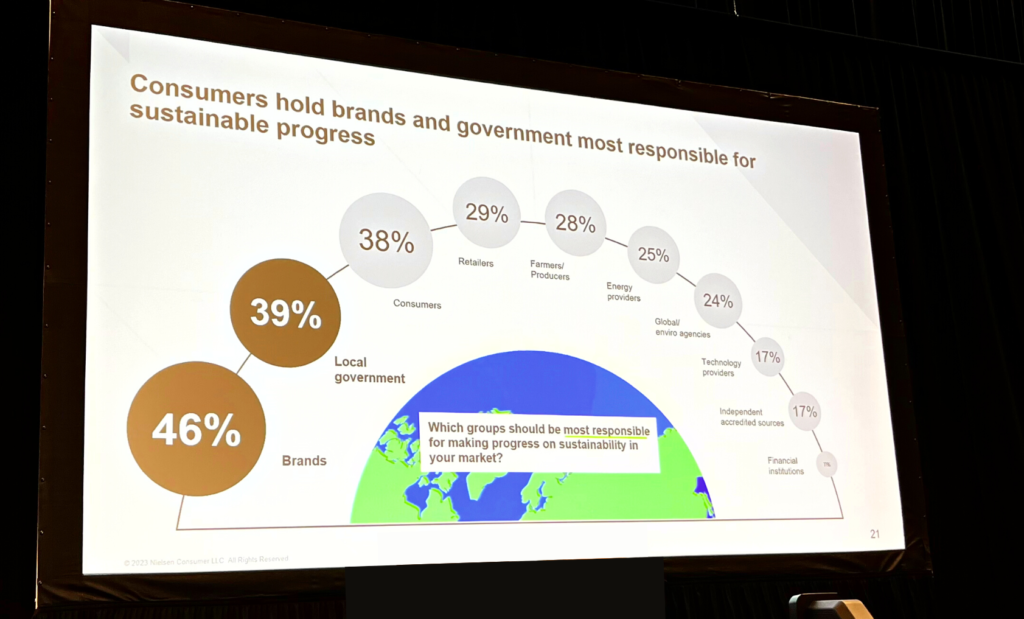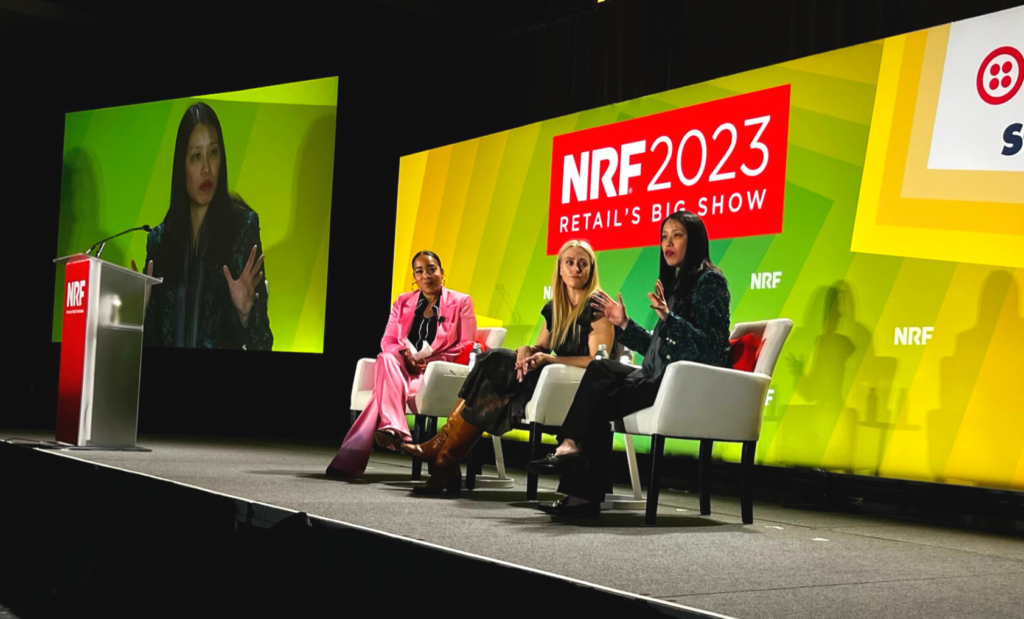NRF 2023, Retail’s Big Show in NYC, was bustling with activity this year. The UpStart Commerce team attended all 3 days of the conference to learn about technology and trends that retail brands are embracing. With 5 floors of activities, there was a lot to see. The following are top trends from NRF Retail’s Big Show 2023, featuring insights from leading retail brands and technology companies on the future of the industry.
Sustainability Is A Purchase Driver
Harvey Ma with NeilsenIQ discussed 6 transformative retail trends that will be prominent in 2023. Consumers continue to seek sustainable options from retailers. NeilsenIQ conducted a survey that asked consumers “Which groups should be most responsible for making progress on sustainability in your market”. Results show that 46% of consumers hold brands responsible, while 39% hold the government responsible for the progress in sustainability.
In the NielsenIQ 2023 Sustainability Report, 26% of consumers also say it is hard to find sustainable options in stores, which is up from 18% in 2018. The average shopper is willing to pay more for a product that is sustainable, or from a brand that proudly announces its commitment to sustainability and eco-friendly practices. This is why ecommerce sites should make sure to announce their stance on sustainability on their homepage and product pages, rather than only on their about pages.

Embracing the Zoöp model
Andrea Bell from WGSN led a session called “Future Drivers 2025: Strategies that will shape your business”. She discussed the importance of sustainability and how companies in the Netherlands embrace the zoöp model. The Zoöp model includes many interlocking parts that hold a space for the voices and interests of non-human life. Will we see this style of thinking trend in other regions of retail in 2023?
How Does the Zoöp model Work?
The zoöp model has 3 sections with unique roles and responsibilities. The 3 entities are Zoönomic Institute, the Zoönomic Foundation, and zoöps. Zoöps are organizations that strive to enable ecological restoration by including non-human life as a part of their decision-making processes. Organizations receive a Zoöp license and a Board Observer Seat at the Zoönomic Foundation that completes an initial assessment. Then they commit to the Zoönomic Annual Cycle.
What is the Zoöp Baseline Assessment?
Organizations do an initial baseline assessment of their ecological standpoint. The assessment considers their economic relationships, legal conditions, and social dimensions. After completing the initial assessment the zoöp establishes annual goals for ecological restoration. They measure goals with transparent methods that make it easy to track their progress. Initial goals can be establishing a green rooftop, removing harmful ingredients, or other urgent changes. The process of ecological regeneration is seen as a process of small changes that combine to make a more sustainable brand.

Surviving the Polycrisis Era
Andrea Bell also highlighted the importance of strategically planning for the polycrisis era during her time on stage. Brands that embrace omnichannel experiences will see the most success during the polycrisis era. Brands with high investments in media are experiencing lower sensitivity to price increases and steady sales. Companies that also embrace friendhsoring and strengthen their Black Swan Team will see the most success during this time.
What is Friendshoring?
After offshoring and reshoring, comes friendshoring. Friendshoring is the act of establishing supply chains and business operations where there are strong alliances. Frienshoring is also referred to as allyshoring. Moving business operations to countries with shared values can help companies withstand uncertain times and diversify the impact of global conflicts. Creating this allyship for supply chain operations can help mitigate economic risk and support countries with shared human rights values.
Why Do Brands Need a Black Swan Team?
A black swan team can help brands prepare for uncertain times. Removing ‘normalcy bias’ allows companies to prepare for unexpected events. Black swan teams create strategic plans that allow companies to thrive and overcome pandemics or other disruptors. Creating this plan ahead of a large event gives the team time to walk thru a variety of different scenarios and ask “what if” questions. Having a prepared action plan for different hypothetical scenarios allows brands to navigate situations while maintaining control. Companies can use their contingency plans to maintain a competitive edge instead of reacting, panicking, or procrastinating in a time of urgency.
Improving Customer Experience Via Search Pages
Kathy Kimple from OSF Digital led a session called “20 strategies and tactics from the Omnichannel Retail Index”. In the session, 4 speakers discussed expectations shoppers have for online retail experiences in 2023. The way that consumers interact with search pages has slowly changed and it is important for ecommerce websites to meet customer expectations. Since the pandemic, people are relying heavily on online shopping. Poor search experiences on an ecommerce website are an easy way to lose a potential customer. Meanwhile, a positive experience with site search can accelerate the shopping journey and create loyal customers.
How to Improve Site Search?
The purpose of the search feature on a website is to provide the user with the information or product they are looking for. Complicating this process will drive potential customers to a competitor’s site. There are simple ways a retailer can improve their ecommerce search page.
Include social proof messaging
Social proof is a trend that continues to grow in the retail industry, and it won’t be stopping in 2023. Social proof messaging can help build brand credibility and reinforces a consumer’s trust in the products. Highlighting how many products were purchased in a specific time frame, how many people have the item in their cart, or other messaging strengthens brand credibility. Therefore, placing social proof messaging at the right place, at the right time, with real-time data can increase conversions and AOV.
Customers trust brands that place customer support information in highly visible locations such as the navigation bar. This shows consumers that the brand values its customers and cares about making situations right.
Restructure Blank Search Pages
Companies that build unique pages for blank search result pages can help convert sales to similar products or redirect them to customer support for further assistance. Including similar products and an easy way to contact customer support creates a valuable online experience versus the old way with a simple page that says ”No Results Found”.
Accessibility Features
Website accessibility is very important for online users. Offering a simple way to access the accessibility features helps users have a positive search experience. In addition, including a label on the search bar and a readable icon allows screen readers to guide visually impaired users to the search function. It is important to utilize alt tags, keyboard-accessible functions, and proper focus order on search result pages to create a seamless experience.
Embracing Gen Z As Shoppers
Many of the sessions at NRF this year discussed embracing the way Gen Z shoppers interact with brands. Gen Z shoppers exist in an “always on” environment. This means that they are constantly connected to technology, as well as retail. Strengthening omnichannel experiences that meet these new young shoppers where they are, allows brands to increase their awareness and connect with Gen Z shoppers. Gen Z appreciates brands that are authentic and meaningful. This requires retailers to segment and study their audiences to create differentiated campaigns for separate target audiences.
Mei Chen from Alibaba Group spoke during a featured session about segmenting generations into even smaller groups that focus on their individual shopping habits. During the session, they broke down 6 different buyer personas that exist amongst one generation of shoppers.

Gen Z and Social Commerce
True to the “always on” claim, Gen Z consumers are turning to social commerce for their shopping needs. However, brands first need to establish trust from this savvy audience and sell without pushing. Retailers have noticed that Gen Z responds best to brands that connect with their audience in a memorable way without focusing on promoting products.
Gen Z is a demographic of online shoppers who have grown up in a world that always included online retail. This means that their shopping habits are different than past generations. They do not need traditional “call to action” prompts that advertisers are used to including. Gen Z consumers already assume “links are in bio” and do not need heavy handholding to be persuaded to shop. When compelled to buy, they can easily navigate thru a frictionless buying journey.
Data-Driven AI For Profitability
Another retail trend growing in 2023 that was discussed is utilizing AI to increase profits. Impact Analytics led a session that highlighted the profitability that AI can bring to retailers. AI technology can now analyze market insights, supply chain, merchandising analytics, and consumer insights to leverage personalized offers and retail media. Using this technology automates the decision-making process for promotions and sales, as well as informs retailers about shopping behaviors. Leveraging this new collaboration process allows brands to increase profits by removing guesswork and reducing the need to A/B test new ideas. Creating promotions that resonate with shoppers not only leads to more profits for the brand but also creates loyal shoppers.

Enhancing Omnichannel Experiences
Many NRF sessions this year had an underlying theme of strengthening and growing omnichannel efforts. Retailers are noticing a resurgence of in-store shoppers. It is crucial to build omnichannel experiences that connect digital and physical shopping to create seamless shopping journeys. As heard across multiple sessions at NRF, the pandemic changed both consumer habits and expectations. In order to retain loyal customers and capture new audiences, retailers must understand their consumers.
Omnichannel Expectations in 2023
- Shoppers now expect to be able to add items to their cart while on a mobile app, then visit the website on a desktop and still access the items in their cart.
- GenZ shoppers expect to be able to shop via social media, mobile apps, and in-store.
- Consumers want the ability to shop online and schedule a pickup time at a local brick-and-mortar location.
- Online purchase, in-store returns is a growing retail trend for consumers in 2023.
In conclusion, 2023 will reinforce the importance of embracing retail trends that change to navigate the polycrisis era and shifts in consumer behavior. Sustainability is becoming a major driving force behind purchasing decisions, and retailers must prioritize sustainable practices to stay competitive. To survive in this constantly changing industry, retailers must have a strategic plan in place, including strategies such as “friendshoring” and creating a “black swan team.” Additionally, search pages and omnichannel experiences are crucial for improving the customer experience and building loyalty. By embracing these trends in 2023 and utilizing data-driven AI to analyze market insights, retailers can future-proof their brands and stay ahead of the curve in the retail industry.
